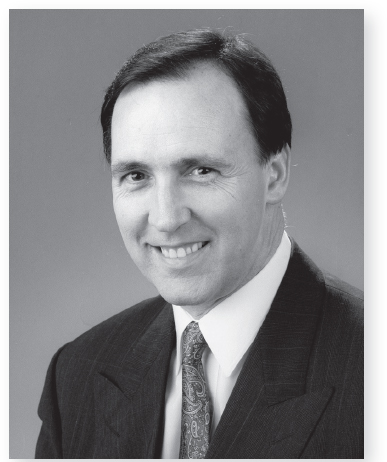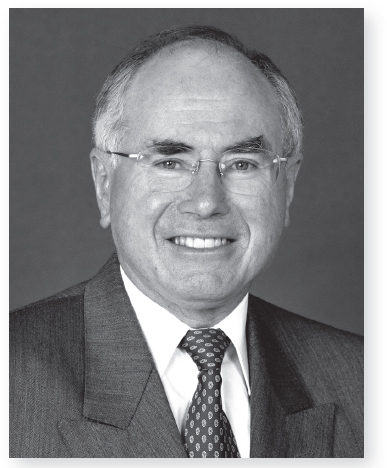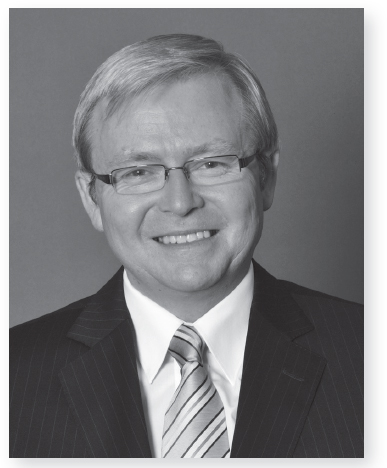First Among Equals (11 page)
Read First Among Equals Online
Authors: Kim; Derry Hogue; Wildman

With the opposition in disarray Hawke was reelected comfortably in 1984, 1987 and 1990. However, with Australia heading for a recession, the electorate began to turn and Hawke's popularity began to decline. Keating then began to conspire against him. After claiming that Hawke had reneged on a secret agreement to step down after winning the 1990 election, in June 1991 Keating resigned from cabinet and challenged the leadership. Although initially unsuccessful, six months later Keating won the leadership.
Two months later Hawke retired from parliament. He then worked in several high-profile media positions, interviewing political figures for the Channel 9 television network and writing a weekly column for a Sunday paper. In 1994, he published
The Hawke Memoirs,
then, a year later, after divorcing his wife Hazel, he married Blanche d'Alpuget, the author of his 1982 biography. In 1999 he publicly campaigned for a republic in the national referendum. Today, Hawke continues to pursue diverse business interests and occasionally makes public appearances.

PAUL JOHN KEATING
THE PRIME MINISTER WE HAD TO HAVE
TERM
20 December 1991-11 March 1996
B
eginning his political career at the age of 25, Australia's twenty-fourth prime minister, Paul John Keating, was one of the country's youngest ever federal politicians. A keen debater, the impeccably dressed Keating used his biting wit and acid tongue to disarm his parliamentary opponents, introducing to the nation a slew of colourful new phrases.
In contrast to the sophisticated, urbane image he promoted throughout his political career, Keating grew up in the working-class suburb of Bankstown in Sydney. One of four children of Min and Matthew Keating, he was born on 18 January 1944. Keating briefly attended De La Salle College in Bankstown and Belmore Technical College, but never completed his High School Certificate. Leaving school at the age of fifteen, Keating found a job as a pay clerk at Sydney's Electricity Authority and joined the Bankstown branch of the Australian Labor Party.
In the early 1960s Keating came under the influence of the radical Labor figure Jack Lang, with whom he met regularly to discuss politics. Keating also worked as the manager for the rock band The Ramrods, and became an industrial advocate for the Federated Municipal and Shire Council Employees' Union. In 1966 he became president of Sydney's Labor Youth Council (the forerunner of Young Labor). Then, at the age of 25, he was elected to the House of Representatives for the Sydney seat of Blaxland on 25 October 1969.
Keating served on the backbench for most of the Whitlam era until 1975 when he was made the minister for Northern Australia, three weeks before Whitlam was dismissed. That same year he married Annita van Iersel, an Alitalia flight attendant, at her family's village in Holland.
In opposition Keating served as the spokesperson for several shadow ministries before being appointed shadow treasurer in 1983. When Hawke came to power that year, Keating retained his position as treasurer. With little education and only three weeks' ministerial experience, Keating worked quickly to acquaint himself with the intricacies of economic policy. Eighteen months later he was named the Finance Minister of the Year by
Euromoney
magazine.
Holding the position until 1991, Keating was the driving force behind the Labor government's economic reforms, including deregulation of the banking system, tariffs reduction, floating the Australian dollar and extensive tax reforms. These reforms helped to modernise and expand the Australian economy and won Keating much praise. However, following the 1987 stock market crash the economy began to stall and, with several high-profile corporations subsequently failing, support for the Liberal Party surged.
With the Hawke government faltering, Keating felt it was time for a change of leadership. In 1988, Keating and Hawke repeatedly met at Kirribilli House and agreed that after the 1990 election Hawke would step down in favour of Keating. Hawke, however, reneged on the deal. Thus, on 3 June 1991 Keating challenged Hawke for the leadership. After caucus backed Hawke, a defeated Keating resigned as treasurer and returned to the backbench. Six months later, however, Keating again made a bid for the leadership, this time deposing Hawke and claiming the prime-ministership on 20 December 1991.
As Keating came to power the country was slipping further into recession and unemployment began to rise. Despite opposition, Keating continued with his program of market reform. Defending his government's policies, Keating famously argued: âThis is the recession we had to have.' Keating also worked to promote his âbig picture' of Australia's future, encouraging the process of reconciliation and the recognition of indigenous Australians' land rights, pushing for economic and cultural engagement with Asia and making Australia a republic.
These policies failed to engage working-class and rural Australians. Seizing the opportunity, the Liberal Party, now led by John Hewson, launched their âFightback' campaign and looked set to win the next election. However, the Liberal Party's policies hinged
on the introduction of a goods and services tax (GST), which frightened the electorate. Thus, in March 1993, the Labor Party won the âunwinnable' election and was returned to office. Yet three years later, with foreign debt mounting and high interest rates and unemployment, the electorate's mood changed and in March 1996 John Howard led the Liberal Party back into office. Keating immediately resigned from parliament.
In his retirement Keating has pursued a number of business interests and is also a Visiting Professor of Public Policy at the University of New South Wales. In March 2000 Keating published
Engagement: Australia Faces the Asia-Pacific,
which detailed his government's policies during his time as prime minister.

JOHN WINSTON HOWARD
THE RESURRECTION OF LAZARUS
TERM
11 March 1996-3 December 2007
O
nce asked if he believed he had another chance at the Liberal Party leadership, John Howard famously replied that a return would be like âLazarus with a triple bypass'. Against all odds, after losing an election and the Liberal Party leadership, Howard rose from the ashes and went on to become only the second person since Federation (the other was his hero, Sir Robert Menzies) to serve for more than ten years as prime minister.
The youngest of four children, John Winston Howard was born in the Sydney suburb of Earlwood on 26 July 1939. His parents, Lyall and Mona, ran a local petrol station, where Howard worked in his younger years. Howard was educated at Earlwood Primary School and Canterbury Boys High School, before studying law at the University of Sydney, graduating in 1961. He was then appointed as a solicitor of the New South Wales Supreme Court in July 1962.
Having joined the Young Liberal Movement at the age of eighteen, Howard was elected president of the New South Wales Young Liberals in 1962. The next year he became a member of the Liberal Party State Executive and consequently served as vice-president of the New South Wales Division from 1972 to 1974. On 4 April 1971, Howard married Janette Parker and the couple moved to Sydney's North Shore. Two years later, Howard entered federal parliament, winning the seat of Bennelong.
When Fraser seized power in 1975, Howard was appointed the minister for business and consumer affairs. In 1977 he became the minister for special trade negotiations with the European Economic Community, and that same year became treasurer at the age of 38. A strong supporter of economic reform, Howard pushed for cuts to personal- and business income tax and the lowering of government spending. Fraser, however, was more conservative and refused to implement Howard's reforms (many of which were embraced by the subsequent Labor government).
Following the Liberal's 1983 defeat, Howard became deputy leader of the opposition and shadow treasurer. In September 1985 he replaced Andrew Peacock as leader of the Liberal Party, a role he retained until 1989 when Peacock usurped him and regained control of the leadership. The Liberal Party leadership went through two more leaders â John Hewson and Alexander Downer â before John Howard again became leader in 1995.
With the electorate growing disenchanted with Labor, Howard easily won the 1996 election. In his first year in office, following the Port Arthur massacre in which 35 people were killed, Howard introduced legislation to heavily restrict the private ownership of guns. Fulfilling his promise to cut the national deficit, he implemented a wide range of economic reforms,
including cost-cutting in the public service, increased university fees and the privatisation of Telstra.
In 1998, despite a large swing against it, Howard's Liberal government was elected back into office. Howard now pushed on with one of his key reforms: the introduction of a GST, which was eventually achieved in July 2000. A staunch monarchist, Howard campaigned against a republic in the 1999 referendum and, in spite of wide condemnation, refused to offer a formal national apology for the government's mistreatment of indigenous Australians.
Internationally, during his second term, Howard increased Australia's involvement in the Asia-Pacific region, sending a peacekeeping force in September 1999 to restore order in East Timor. Then, following the terrorist attacks on New York and Washington on 11 September 2001, Howard joined the âwar on terror', sending Australian troops to fight in Afghanistan and Iraq.
Despite the controversy surrounding his tough stance on asylum seekers, which saw the government refuse to allow the Norwegian freighter MV
Tampa
(carrying a group of asylum seekers picked up in international waters) to enter Australian waters, and then culminated in October with the âChildren Overboard Affair', where the government falsely claimed that asylum seekers had deliberately thrown
their own children into the seaâin order to be rescued by HMAS
Adelaide
and gain entry into Australia â Howard was returned to office that year on a campaign promoting tougher border security.
Following the October 2002 Bali bombing in which 88 Australians were killed, Howard continued to push his agenda for national security. With the âwar on terror' now closer to home, Howard easily won the October 2004 federal election, this time with an even larger majority. In the years following, however, his party became embroiled in a number of controversies, specifically the Australian Wheat Board scandal and the ongoing argument over his retirement. Moreover, in 2005, he introduced extremely unpopular industrial relations changes that alienated some of his own supporters, and with the war in Iraq seemingly without end, the mood of the country shifted. After so many years in parliament, many believed Howard had lost touch with the electorate.
On 14 October 2007, after much speculation, Howard finally set the date for the country's long-anticipated federal election. With Kevin Rudd having now replaced Kim Beazley as Labor Party leader, by the time the ink had dried on the election writs the Coalition was already behind in the polls with many experts predicting a landslide Labor victory. In spite of Howard's assurance to the Australian public that
his coalition government was the âright leadership' for the country, the electorate thought otherwise and, in the worst defeat of an incumbent government since Federation, on 24 November the Coalition was resoundingly swept from office. Adding insult to injury, Howard also lost his seat of Bennelong to Labor's new star recruit, former journalist Maxine McKew, becoming only the second Australian prime minister to lose his own seat (the other was Stanley Bruce in 1929).
A despondent Howard retired from office on 3 December 2007 when Kevin Rudd was officially sworn in as the country's newest prime minister. In January 2008, Howard then followed in the footsteps of former British prime minister Tony Blair, signing on as a professional speaker with the Washington Speakers Bureau.
